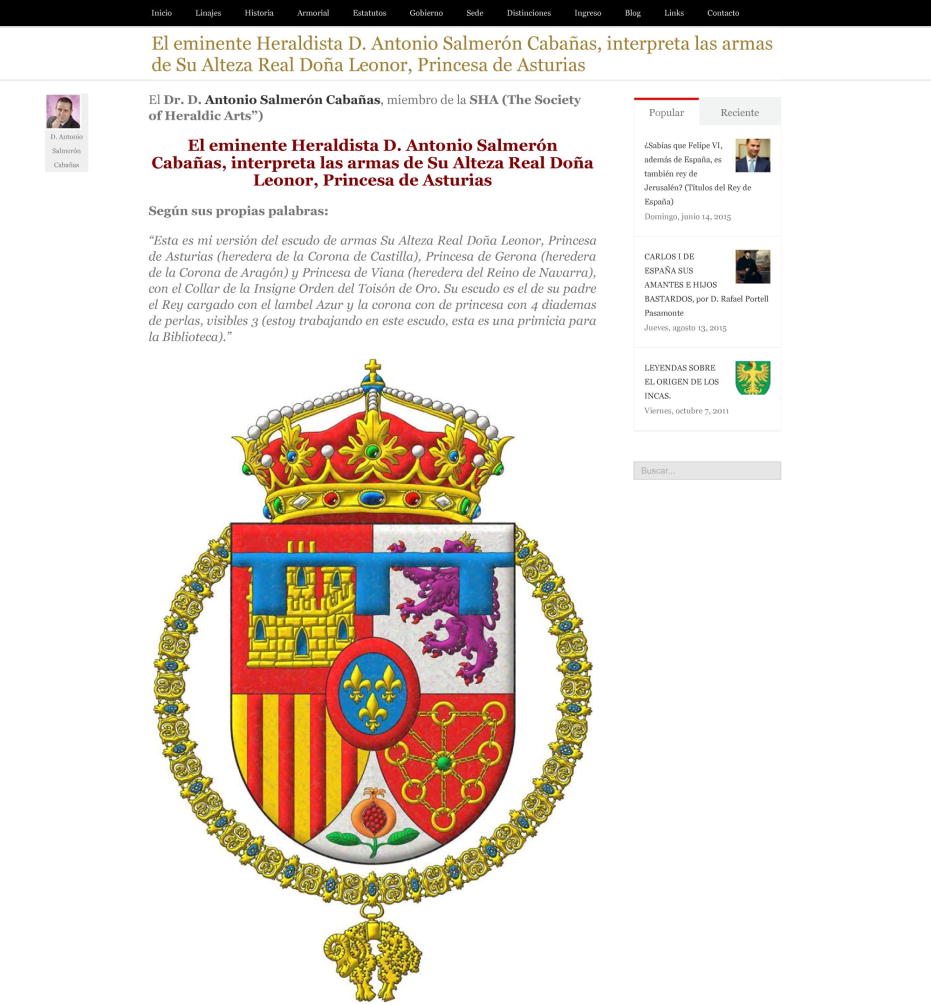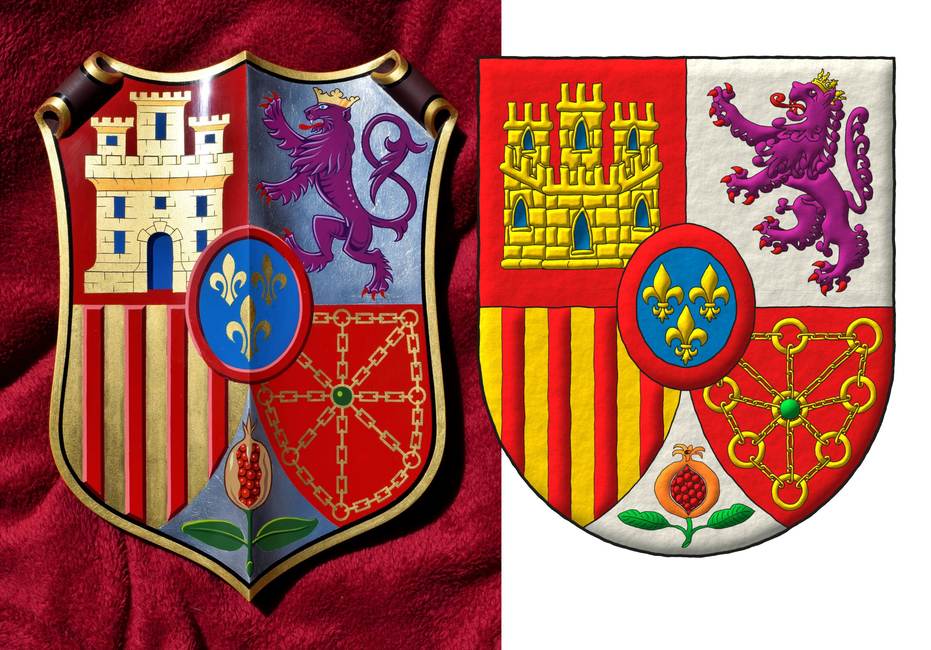Emerald


Blasón de Navarra en el armorial Urfé
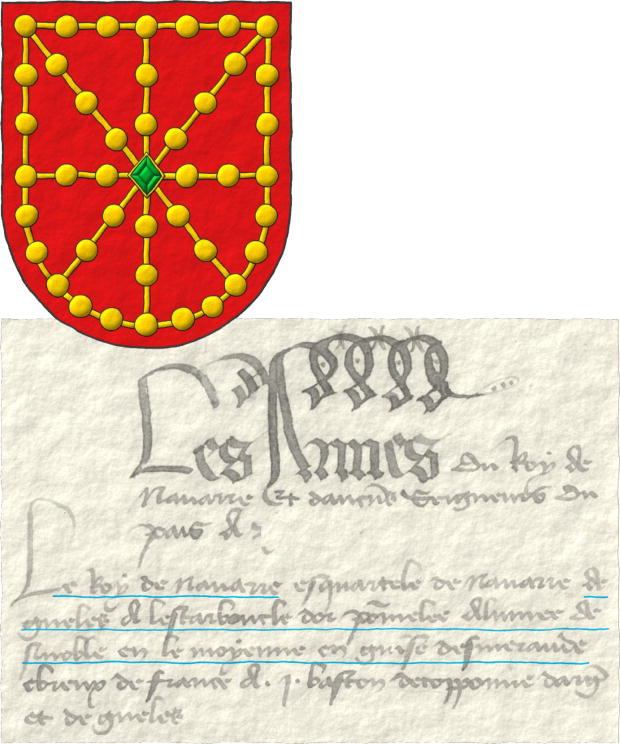
Escudo de gules, un carbunclo cerrado, pomelado de oro; cargado en el centro de una esmeralda en forma de losange de sinople.
The armorial [Urfé; 15th century] contains only blazons written in French and is not decorated with shields.
The image shows my interpretation of the arms and, beneath it, the blazon of the king of Navarre as follows «Le Roy de Navarre... de gueles à l'escarboucle d'or pommelée alumée de sinoble en la moyenne en guise d'esmeraude» which could be translated as «The King of Navarre... Gules, a carbuncle Or pommetty, illuminated Vert in the middle in the manner of an emerald».
Note that the blazon does not suggest the presence of an emerald, but that the place corresponding to the central boss of the shield, from which the rays of the carbuncle emerge, is enamelled Vert.
In the article Universitas Studiorum Navarrensis about the arms of the University of Navarre I interpret the arms of Navarre borne in profile by the Archangel Saint Michael, which, by my way of painting it, lies halfway between the carbuncle and the chains, with round chain links and long carbuncle rays, where at the centre there is no emerald, but a Vert enamel in the manner of an emerald.
Blazon keywords: Without divisions, Gules, One, Carbuncle, Pommelled, Or, Charged, In the fess point, Emerald, Vert and Lozenge.
Style keywords: Soft metal, Illuminated, Outlined in sable and Shaded.
Classification: Interpreted, Civic and Coat of arms.
Bearer: Navarre.


![Ver [Bosque, J. del; 1540] en referencias bibliográficas. Libro abierto, hojas de plata, filo de oro, guardas de gules, tapas de sable.](../css/Libro.Bibliografia.png)
Bosque, J. del; 1540
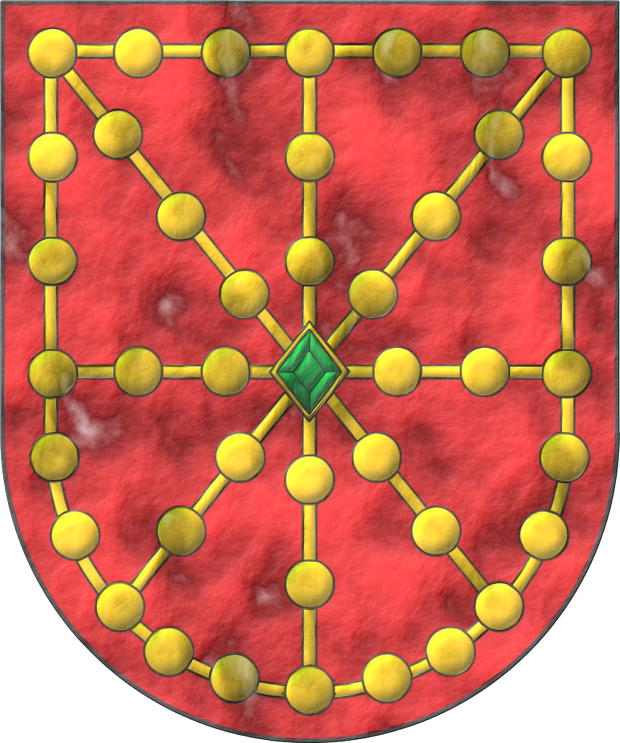
Juan del Bosque, «Libro de Armería del Reino de Navarra», which is currently missing and whose subsequent copy, commissioned in 1572, is kept in the Royal and General Archive of Navarre, estimated year of creation 1540.
The origin of this armorial dates back to 1527, when the Navarrese Courts requested that the Royal Council and the Chamber of Comptos ~ Chamber of Accounts and Fiscal Control, record in a book the coats of arms of the kingdom of Navarre starting with that of the king of Navarre and the houses and lineages of the so-called «ricoshombres», Almorrabides, Guebara, Aybar, Baztanes, Urroz, Lete, Subiça, Rada, Vidaurre, Qasqante, Monteagudo, and Mauleón, also including the coats of arms of other manors, houses, valleys, towns, and nobles [Valverde Ogallar, P. B.; 2001; page 326].
According to [Martinena Ruiz, J. J.; 1982; page 35] the book was compiled around the year 1540, and this is the date I use for referencing this armorial.
This first manuscript created by Juan del Bosque was taken by the royal visitor Hernán Suárez de Toledo, under the pretext of taking it to Emperor Charles V, despite being requested back by the Navarrese Courts, it was never returned and was definitively lost. The armorial that has come down to us is a recreation commissioned in 1572 [Valverde Ogallar, P. B.; 2001; page 327].
According to [Menéndez Pidal de Navascués, F.; 1974; page 19] the recreation of this armorial was carried out based on certifications, such as those from the herald Azcárraga, and notes and partial copies of the stolen book, like the copy kept in the monastery of Leyre.
Another noteworthy bibliographic reference about this armorial, in addition to those previously mentioned, is [Martinena Ruiz, J. J.; Menéndez Pidal de Navascués, F.; 2001].
The image illustrating this bibliographic reference is the coat of arms of the king of Navarre, which I recreated based on the illustration in this armorial, on its first folio according to the numbering given to it in 1613.
Bibliographical reference of century XVI.
Author: Bosque, Juan del.
Here are the articles quoting this reference:
- Almorrabides of Navarre
- Aybar of Navarre
- Baztanes of Navarre
- Guebara of Navarre
- Lete of Navarre
- Martinena Ruiz, J. J.; 1982
- Martinena Ruiz, J. J.; Menéndez Pidal de Navascués, F.; 2001
- Mauleón of Navarre
- Menéndez Pidal de Navascués, F.; 1974
- Menéndez Pidal de Navascués, F.; 1985
- Menéndez Pidal de Navascués, F.; Martínez de Aguirre, J.; 2000
- Monteagudo of Navarra
- Navarra, closed carbuncle
- Navarre
- Noblemen of Navarre
- Qasqante of Navarre
- Rada of Navarre
- Subiça of Navarre
- Urroz of Navarre
- Vidaurre of Navarre


Crown of Her Royal Highness Doña Leonor Princess of Asturias
![Crown of Her Royal Highness Doña Leonor Princess of Asturias Quarterly: 1 Gules, a castle triple-towered Or, port and windows Azure, masoned Sable [for Castile]; 2 Argent, a lion rampant Purpure, armed and langued Gules, crowned Or [for Leon]; 3 Or, four pallets Gules [for Aragon]; 4 Gules, a chain orlewise, crosswise, and saltirewise Or, charged in the fess point with an emerald Vert [for Navarre]; enté en point Argent, a pomegranate proper, seeded Gules, slipped and leaved Vert [for Granada]; an inescutcheon Azure, three fleurs de lis Or, 2 and 1, a bordure Gules [for Bourbon]; and the whole debruised by a label of three points Azure. Crest: A Crown of Prince. The shield is surrounded by the Golden Fleece.](../escudo_armas/LeonorPA.27.Corona.Preciosas.Toison.Irisado.jpg)
Quarterly: 1 Gules, a castle triple-towered Or, port and windows Azure, masoned Sable [for Castile]; 2 Argent, a lion rampant Purpure, armed and langued Gules, crowned Or [for Leon]; 3 Or, four pallets Gules [for Aragon]; 4 Gules, a chain orlewise, crosswise, and saltirewise Or, charged in the fess point with an emerald Vert [for Navarre]; enté en point Argent, a pomegranate proper, seeded Gules, slipped and leaved Vert [for Granada]; an inescutcheon Azure, three fleurs de lis Or, 2 and 1, a bordure Gules [for Bourbon]; and the whole debruised by a label of three points Azure. Crest: A Crown of Prince. The shield is surrounded by the Golden Fleece.
Arms depicted by me, highlighted with lights and shadows, outlined in Sable, with a semi-circular external shape and with a iridescent finish.
This is my interpretation of the coat of arms of Her Royal Highness Doña Leonor Princess of Asturias (as heiress to the Crown of Castile), Princess of Girona (as heiress to the Crown of Aragon), and Princess of Viana (as heiress to the Kingdom of Navarre), with the Collar of the Distinguished Order of the Golden Fleece. Her coat of arms is that of her father, the King, charged with a label Azure and surmounted by the crown of a princess with four pearl diadems, three visible.
Blazon keywords: Gules, Azure, Purpure, Vert, Or, Argent, One, Three, Four, Quarterly, Castle, Triple-towered, Port and windows, Masoned, Lion, Rampant, Crowned, Pallet, Chain, Orlewise, Crosswise, Saltirewise, Charged, In the fess point, Emerald, Enté en point, Pomegranate, Proper, Slipped, Leaved, Inescutcheon, Fleur de lis, Ordered, Bordure, Cadency, Label of three points, Crown of Prince, Crown, Surrounded and Collar.
Style keywords: Outlined in sable, Illuminated, Semi-circular and Iridescent.
Classification: Personal, Kingdom of Spain, Interpreted, Boa and Coat of arms.
Bearer: Leonor Princess of Asturias.


![Ver [Felipe VI and the Order of the Garter in Twelve Lineages] en enlaces recomendados. Áncora de oro y la divisa enlace.](../css/Ancora.Enlace.png)
Felipe VI and the Order of the Garter in Twelve Lineages
Publication of my interpretation of the arms of His Majesty King Felipe VI with the Order of the Garter on the blog Twelve Lineages of Soria with the following text: Magnificent interpretation of the coat of arms of H.M. the King of Spain, with the Order of the Garter, made by the prestigious heraldist and member of the International Heraldry Society, Mr. Antonio Salmerón Cabañas.
Categories: Link, Or, Four, Pale, Gules, Azure, Sable, One, Castle, Port and windows, Masoned, Argent, Purpure, Lion, Rampant, Armed, Langued, Crowned, Chain, Orlewise, Crosswise, Saltirewise, Charged, In the fess point, Emerald, Vert, Closed royal crown, Crown, Inescutcheon, Fleur de lis, Bordure, Enté, In base, Pomegranate, Proper, Seeded (pomegranate), Slipped and Leaved.
Root: Twelve Lineages of Soria.


Felipe VI of Spain and the golden number
Quarterly: 1 Gules, a castle triple-towered Or, port and windows Azure, masoned Sable [for Castile]; 2 Argent, a lion rampant Purpure, armed and langued Gules, crowned Or [for Leon]; 3 Or, four pallets Gules [for Aragon]; 4 Gules, a chain orlewise, crosswise, and saltirewise Or, charged in the fess point with an emerald Vert [for Navarre]; enté en point Argent, a pomegranate proper, seeded Gules, slipped and leaved Vert [for Granada]; an inescutcheon Azure, three fleurs de lis Or, 2 and 1, a bordure Gules [for Bourbon]. Crest: A closed royal crown. The shield is surrounded by the Golden Fleece.
My interpretation endows the coat of arms of His Majesty King Felipe VI of Spain with the golden proportion, based on the golden number Phi, which is present in many works of art, in architecture, in mathematics, and in Nature itself; there are official arms established by Royal Decree 527/2014, and the arms shown here constitute only a new personal interpretation of the same blazon; the shape of the shield is that of the Spanish type with a semicircular base, of height h and base b, with the proportion b/h = 5/6; the shield is placed at the center of a golden rectangle, of height 2h, twice the height of the shield, and of width 2h/Phi, Phi being the golden number, equal to 1.6180339887…; to the set formed by the shield and the golden rectangle a circle of radius h/Phi is added, tangent to both vertical sides of the rectangle and also tangent at the center of the upper boundary of the chief of His Majesty’s shield; this circle forms the edge of the collar of the Order of the Golden Fleece, and from its lowest point the fleece hangs down until it nearly touches the base of the golden rectangle; the golden rectangle is divided into four equal parts, each of height h/2, assigned respectively to the closed royal crown, to Castile and León, to Aragon, Navarre and Granada, and to the lower part of the collar and the Golden Fleece; in this way, the entire coat of arms of His Majesty King Felipe VI can be defined as a function of a single parameter h, corresponding to the height of the shield, and the dimensions specified in terms of the base b are likewise functions of h thanks to the proportion b = 5h/6.
Blazon keywords: Gules, Azure, Purpure, Vert, Or, Argent, One, Three, Four, Quarterly, Castle, Triple-towered, Port and windows, Masoned, Lion, Rampant, Crowned, Pallet, Chain, Orlewise, Crosswise, Saltirewise, Charged, In the fess point, Emerald, Enté en point, Pomegranate, Proper, Slipped, Leaved, Inescutcheon, Fleur de lis, Ordered, Bordure, Closed royal crown, Crown, Surrounded and Collar.
Style keywords: Ratio, Outlined, Outlined in sable, Plain tincture and Semi-circular.
Classification: Personal, Kingdom of Spain, Interpreted, Schema, Boa and Coat of arms.
Bearer: Felipe VI of Spain.


Kingdom of Spain, collage
Quarterly: 1 Gules, a castle triple-towered Or, port and windows Azure, masoned Sable; 2 Argent, a lion rampant Purpure, armed and langued Gules, crowned Or; 3 Or, four pallets Gules; 4 Gules, a chain orlewise, crosswise, and saltirewise Or, charged in the fess point with an emerald Vert; enté en point Argent, a pomegranate proper, seeded Gules, slipped and leaved Vert; an inescutcheon Azure, three fleurs de lis Or, 2 and 1, a bordure Gules. Crest: A closed royal crown. Supporters: two columns Argent, capital and base Or, between in base waves Azure, in chief an imperial crown the dexter and a closed royal crown the sinister. Moto environing the columns and behind the shield: «Plus Ultra» Or over a scroll Gules.
Arms of the Kingdom of Spain. This image combines three photographs of this coat of arms on the façade of the Ministry of Defence building on the Paseo de la Castellana in Madrid, just a few metres from my office, together with my own artistic interpretation of the same arms. In the version on the façade of the Ministry of Defence, the crowns above the columns do not touch the columns, which I believe is the correct way to depict them, although the central crown does appear to rest upon the shield of Spain. There are more interpretations that place the crowns resting on the columns than those that do not, and I photographed this particular version from the Ministry of Defence because it is especially relevant due to its size and institutional significance. On the arrangement of the crowns: a) Royal Decree 1511/1977, of 21 January, enacted during the so-called Transition and approving the Regulations on Flags and Standards, Guidons, Insignia and Distinctive Signs, states: «Rule No. 2. Coat of Arms of Spain… Accompanied by two columns Argent, with base and capital Or, set upon waves Azure or blue and Argent», «superado» «by an imperial crown on the dexter one and by a royal crown on the sinister one…». b) The subsequent Law 33/1981, of 5 October, regulating the current coat of arms of Spain, likewise states: «…Accompanied by two columns Argent, with base and capital Or, set upon waves Azure or blue and Argent», «superado» «by an imperial crown on the dexter one and by a royal crown on the sinister one». c) The term «superado» in the heraldic dictionaries in which it appears refers, as a synonym, to «surmontado». d) The definitions of «surmontado» include: «a charge which, at its upper part, has another above it but without touching it», «also said of superado», and «a figure that bears another above it, but without touching it». In light of a), b), c) and d), the two crowns should therefore be painted not touching the columns. However, in the illustrative drawing contained in Royal Decree 1511/1977 the crowns do touch the columns, contradicting its own wording, although in heraldry, when in doubt, the written blazon always prevails; and in most official representations the crowns do indeed touch the columns. Nevertheless, this personal interpretation of both the coat of arms of Spain and of the proper way to write its blazon, where the lateral crowns do not touch the columns, and then I decide that, following the same criterion, the central crown should not touch the shield either, so the result differs from the official version.
Blazon keywords: Gules, Azure, Purpure, Vert, Or, Argent, One, Two, Three, Four, Quarterly, Castle, Triple-towered, Port and windows, Masoned, Lion, Rampant, Crowned, Pallet, Chain, Orlewise, Crosswise, Saltirewise, Charged, In the fess point, Emerald, Enté en point, Pomegranate, Proper, Slipped, Leaved, Inescutcheon, Fleur de lis, Ordered, Bordure, Closed royal crown, Crown, Supporter (thing), Supporter, Column, Shafted, Between, In base, Wave, In chief, Imperial crown, Dexter, Sinister, Motto, Environed, Behind the shield and Scroll.
Style keywords: Outlined in sable, Illuminated and Semi-circular.
Classification: Civic, Kingdom of Spain, Interpreted, Boa, Photographic and Collage.
Bearer: Spain, Kingdom of.


Kingdom of Spain, schema 4x6
Quarterly: 1 Gules, a castle triple-towered Or, port and windows Azure, masoned Sable [for Castile]; 2 Argent, a lion rampant Purpure, armed and langued Gules, crowned Or [for Leon]; 3 Or, four pallets Gules [for Aragon]; 4 Gules, a chain orlewise, crosswise, and saltirewise Or, charged in the fess point with an emerald Vert [for Navarre]; enté en point Argent, a pomegranate proper, seeded Gules, slipped and leaved Vert [for Granada]; an inescutcheon Azure, three fleurs de lis Or, 2 and 1, a bordure Gules [for Bourbon].
The image shows the coat of arms of the Kingdom of Spain and, surrounding it, the coats of arms that compose it, arranged radially in order to make their integration into the greater arms visually explicit, there are the arms of Castile, Leon, Aragon, Navarre, and Granada, together with the central inescutcheon of the reigning dynasty. The technical delineation visible in the dexter part of the image reveals a geometric construction based on regular proportions. The central shield establishes the main module, from which arcs and axes are drawn to fix the placement of the surrounding shields.
Blazon keywords: Gules, Azure, Purpure, Vert, Or, Argent, One, Three, Four, Quarterly, Castle, Triple-towered, Port and windows, Masoned, Lion, Rampant, Crowned, Pallet, Chain, Orlewise, Crosswise, Saltirewise, Charged, In the fess point, Emerald, Enté en point, Pomegranate, Proper, Slipped, Leaved, Inescutcheon, Fleur de lis, Ordered and Bordure.
Style keywords: Ratio, Outlined, Outlined in sable, Illuminated, Semi-circular and Freehand.
Classification: Civic, Kingdom of Spain, Interpreted, Schema, Boa and Coat of arms.
Bearer: Spain, Kingdom of.


Leonor Princess of Asturias
![Leonor Princess of Asturias Quarterly: 1 Gules, a castle triple-towered Or, port and windows Azure, masoned Sable [for Castile]; 2 Argent, a lion rampant Purpure, armed and langued Gules, crowned Or [for Leon]; 3 Or, four pallets Gules [for Aragon]; 4 Gules, a chain orlewise, crosswise, and saltirewise Or, charged in the fess point with an emerald Vert [for Navarre]; enté en point Argent, a pomegranate proper, seeded Gules, slipped and leaved Vert [for Granada]; an inescutcheon Azure, three fleurs de lis Or, 2 and 1, a bordure Gules [for Bourbon]; the whole debruised by a label of three points Azure.](../escudo_armas/LeonorPA.21.CoA.TrazoAlzado.jpg)
Quarterly: 1 Gules, a castle triple-towered Or, port and windows Azure, masoned Sable [for Castile]; 2 Argent, a lion rampant Purpure, armed and langued Gules, crowned Or [for Leon]; 3 Or, four pallets Gules [for Aragon]; 4 Gules, a chain orlewise, crosswise, and saltirewise Or, charged in the fess point with an emerald Vert [for Navarre]; enté en point Argent, a pomegranate proper, seeded Gules, slipped and leaved Vert [for Granada]; an inescutcheon Azure, three fleurs de lis Or, 2 and 1, a bordure Gules [for Bourbon]; the whole debruised by a label of three points Azure.
Escudo cuartelado: 1o de gules, un castillo de oro, aclarado de azur, mazonado de sable [de Castilla]; 2o de plata, un león rampante de púrpura, lampasado y armado de gules, coronado de oro [de León]; 3o de oro, con cuatro palos de gules [de Aragón]; 4o de gules, una cadena puesta en orla, en cruz y en sotuer de oro, cargada en el centro de una esmeralda de sinople [de Navarra]; entado en punta de plata, una granada al natural, tajada de gules, tallada y hojada de sinople [de Granada]; un escusón de azur, tres flores de lis de oro, 2 y 1, una bordura de gules [de Borbón]; brisado de un lambel de tres pendientes de azur.
Arms emblazoned by me, illuminated with lights and shadows, contoured in Sable, with a semi-circular outer contour and with a freehand finishing.
This is the coat of arms of Her Royal Highness Doña Leonor Princess of Asturias, Princess of Girona, and Princess of Viana, heiress of the throne of Spain as the elder daughter of King Felipe VI and Queen Letizia. This version of her coat of arms has been emblazoned by me. The coat of arms of the Princess of Asturias is the same as her father's, the King, but with a mark of cadency which, in heraldic terms, is also know as brisure. In this case, the cadency mark is a label Azure with three points, which will be removed in due course. The label of three points is the main and most classic of the brisures, usually assigned to the eldest heir. It is said to originate from a piece of cloth the son would tie at the top of his shield to distinguish it from his father's. Other common brisures include the crescent, the mullet of five point, the marlet, the annulet, or the fleur de lis. In addition to these simple brisures, there are also combined brisures, which are brisures charged with another or others. For example, a crescent charged with a fleur de lis. Labels may also have their points charged with other marks. Many cadency systems become more complicated as generations progress and branches open up, so they tend to be rarely used except in very clear cases like this one.
Blazon keywords: Gules, Azure, Purpure, Vert, Or, Argent, One, Three, Four, Quarterly, Castle, Triple-towered, Port and windows, Masoned, Lion, Rampant, Crowned, Pallet, Chain, Orlewise, Crosswise, Saltirewise, Charged, In the fess point, Emerald, Enté en point, Pomegranate, Proper, Slipped, Leaved, Inescutcheon, Fleur de lis, Ordered, Bordure, Cadency and Label of three points.
Style keywords: Outlined in sable, Illuminated, Semi-circular and Freehand.
Classification: Personal, Kingdom of Spain, Interpreted, Boa and Coat of arms.
Bearer: Leonor Princess of Asturias.


![Ver [Leonor, Princess of Asturias, Girona, and Viana in Twelve Lineages] en enlaces recomendados. Áncora de oro y la divisa enlace.](../css/Ancora.Enlace.png)
Leonor, Princess of Asturias, Girona, and Viana in Twelve Lineages
Publication of my interpretation of the arms of Her Royal Highness Princess Leonor, Princess of Asturias (heir to the Crown of Castile), Princess of Girona (heir to the Crown of Aragon), and Princess of Viana (heir to the Kingdom of Navarre), with the Collar of the Illustrious Order of the Golden Fleece, her coat of arms being that of her father the King, charged with a label Azure and surmounted by the princess's crown with four pearl diadems, of which three are visible. Publication made on the blog Twelve Lineages of Soria with the following text: The eminent heraldist Mr. Antonio Salmerón Cabañas interprets the arms of Her Royal Highness Princess Leonor, Princess of Asturias.
Categories: Link, Or, Four, Pale, Gules, Azure, Sable, One, Castle, Port and windows, Masoned, Argent, Purpure, Lion, Rampant, Armed, Langued, Crowned, Chain, Orlewise, Crosswise, Saltirewise, Charged, In the fess point, Emerald, Vert, Crown of Prince, Crown, Inescutcheon, Fleur de lis, Bordure, Enté, In base, Pomegranate, Proper, Seeded (pomegranate), Slipped, Leaved and Label.
Root: Twelve Lineages of Soria.


Navarra, closed carbuncle
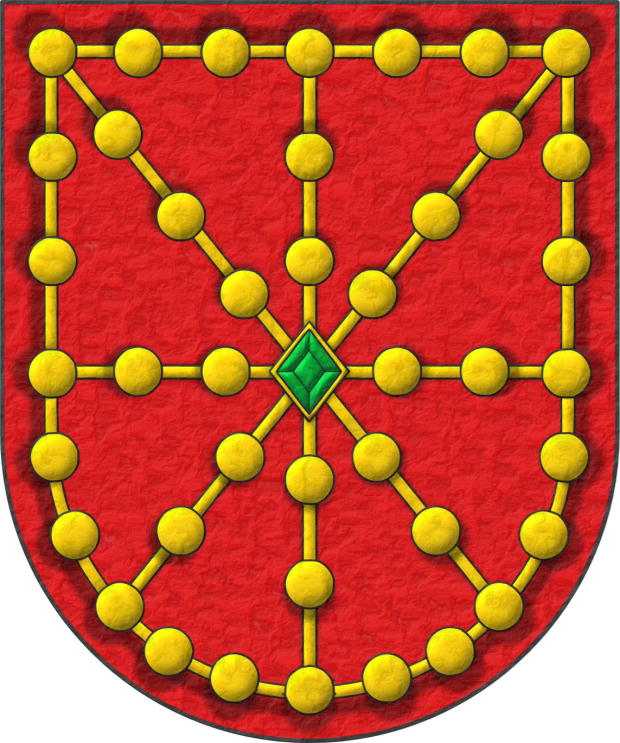
Escudo de gules, un carbunclo cerrado, pomelado de oro; cargado en el centro de una esmeralda en forma de losange de sinople.
Coat of arms interpreted with: a semicircular (round) base; the field in flat Gules; the pommetty carbuncle and the emerald illuminated in Or and Vert, shaded and outlined in Sable; and the whole finished in lightly-hammered metal.
In addition to historical documents such as the armorials [Urfé; 15th century] which blazons it and [Bosque, J. del; 1540] which illustrates it, there is, in the last half century, an abundant bibliography on the arms of Navarre, for example: [Menéndez Pidal de Navascués, F.; 1963], [Menéndez Pidal de Navascués, F.; 1974], [Martinena Ruiz, J. J.; 1982], [Menéndez Pidal de Navascués, F.; 1999], [Menéndez Pidal de Navascués, F.; Martínez de Aguirre, J.; 2000], [Martinena Ruiz, J. J.; Menéndez Pidal de Navascués, F.; 2001] and [Martínez de Aguirre, J.; 2007].
This pommetty shield can also be seen, for example, on the outer façade of the convent of Santo Domingo in Estella, on capitals preserved in the Cathedral of Tudela and on capitals of the church of Santa María la Real of Laguardia, the latter dating from the 14th century.
Blazon keywords: Without divisions, Gules, One, Carbuncle, Pommelled, Or, Charged, In the fess point, Emerald, Vert and Lozenge.
Style keywords: Soft metal, Illuminated, Outlined in sable and Shaded.
Classification: Interpreted, Civic and Coat of arms.
Bearer: Navarre.


The Arms of Felipe VI for the Order of the Garter at Windsor Castle by Baz Manning
Quarterly: 1 Gules, a castle triple-towered Or, port and windows Azure, masoned Sable; 2 Argent, a lion rampant Purpure, armed and langued Gules, crowned Or; 3 Or, four pallets Gules; 4 Gules, a chain orlewise, crosswise, and saltirewise Or, charged in the fess point with an emerald Vert; enté en point Argent, a pomegranate proper, seeded Gules, slipped and leaved Vert; an inescutcheon Azure, three fleurs de lis Or, 2 and 1, a bordure Gules.
The British heraldic artist Baz Manning, responsible for painting the coats of arms of the Order of the Garter in St George’s Chapel at Windsor Castle, produced in polychromed wood the armorial bearings of His Majesty King Felipe VI of Spain following his admission into the Order. During this process, I had the honour of assisting him by providing official documentation, explaining the heraldic differences between the arms of Juan Carlos I and Felipe VI, clarifying various points, and reviewing the final details of the work prior to its installation in Windsor. The illustration accompanying this post is a collage made from a photograph of the completed shield, crafted by him in painted wood, sent to me by Baz Manning while it was drying, with explicit instructions not to publish it until its formal placement in the chapel. I used that image together with my own artistic interpretation of the King’s arms to carry out a detailed, side-by-side verification of every element. Although my contribution was modest, I am deeply proud to have taken part in a work destined to occupy a permanent place within one of the United Kingdom’s most emblematic heraldic settings.
Blazon keywords: Gules, Azure, Purpure, Vert, Or, Argent, One, Three, Four, Quarterly, Castle, Triple-towered, Port and windows, Masoned, Lion, Rampant, Crowned, Pallet, Chain, Orlewise, Crosswise, Saltirewise, Charged, In the fess point, Emerald, Enté en point, Pomegranate, Proper, Slipped, Leaved, Inescutcheon, Fleur de lis, Ordered and Bordure.
Classification: Personal, Interpreted, Painted wood, Boa, Collage and Photographic.
Bearer: Felipe VI of Spain.


University of Navarra
![University of Navarra Emblem Azure, Saint Michael Argent, vested and nimbed Or, grasping in his dexter hand a spear Or, point downward, and in his sinister hand bearing [ Gules, a chain orlewise, crosswise, and saltirewise Or, charged in the fess point with an emerald Vert, of Navarre ], upon a dragon Vert, armed, langued, fanged, and the eyes Gules.](../escudo_armas/UnavN.21.SanMiguel.Plata.Vestido.Oro.jpg)
Emblem Azure, Saint Michael Argent, vested and nimbed Or, grasping in his dexter hand a spear Or, point downward, and in his sinister hand bearing [ Gules, a chain orlewise, crosswise, and saltirewise Or, charged in the fess point with an emerald Vert, of Navarre ], upon a dragon Vert, armed, langued, fanged, and the eyes Gules.
Emblema de azur, un San Miguel de plata, vestido y nimbado de oro, teniendo en su diestra una lanza de oro, con la punta hacia abajo y en su siniestra trae [ escudo gules, una cadena puesta en orla, en cruz y en sotuer de oro, cargada en el centro de una esmeralda de sinople, de Navarra ], sostenido por un dragón de sinople, armado, lampasado, fierezado y encendido de gules.
Emblem interpreted by me as follows: an oval shape with proportions 5x6, wider than the original; the field illuminated in Azure; its charges outlined in Sable and illuminated in the colours Gules and Vert and the metals Argent and Or; the Archangel Saint Michael vested in Or, unlike others who appear in Argent; his emerald simplified into an area enameled Vert; and the whole emblem has a lightly beaten metal finish.
Due to its special characteristics, the difficulty in complying with the first rule of heraldry concerning metals and colours, and out of prudence, I categorize it as an emblem rather than a shield.
In a relief of the Church of Saint Michael the Archangel in Estella, Saint Michael can be seen fighting a dragon that represents the devil, in a similar but mirrored arrangement to that of this emblem. In that relief, the Archangel Saint Michael bears a pre-heraldic shield with its umbo. According to [Menéndez Pidal de Navascués, F.; 1963], the umbo of the shield is a reinforcing element that is the predecessor of what would later become the pommelly carbuncle of the shield of the Kingdom of Navarre.
Blazon keywords: Without divisions, Azure, Male figure, Angel, Archangel, Argent, Vested, Nimbed, Or, Grasping, Dexter, Spear, Point downwards, Sinister, Gules, One, Chain, Orlewise, Crosswise, Saltirewise, Charged, In the fess point, Emerald, Vert, Upon, Dragon, Armed, Langued, The fangs and The eyes.
Style keywords: Oval, Illuminated, Outlined in sable and Soft metal.
Classification: Interpreted, Socioeconomic, Education, Emblem and Kingdom of Navarre.
Bearer: University of Navarra.
-
Language
-
Categories of heraldry
-
Divisions of the field
- Without divisions
- Party per pale
- Party per fess
- Party per bend
- Party per bend sinister
- Tierce
- Tierce sinister
- Tierced per pale
- Tierced per fess
- Tierced per bend
- Tierced pallwise inverted
- Quarterly
- Quarterly per saltire
- Gyronny
- Party per fess, the chief per pale
- Party per pale, the sinister per fess
- Party per fess, the base per pale
- Party per pale, the dexter per fess
- Chapé
- Chaussé
- Embrassé
- Contre-embrassé
- Party per chevron
- Enté
- Enté en point
- Flanched
-
Metals
-
Colours
-
Furs
-
Other tinctures
-
Ordinaries and sub-ordinaries
-
Diminutives of the ordinaries
-
Geometric charges
-
Composite ordinaries
-
Inanimate charges from Nature
Atom, Crescent, Diamond, Emerald, Estoile, Increscent, Lightning flash, Moon, Mount, Mullet, Mullet of four points, Orbital, Plough of Ursa Major, Rainbow, Ray of the sun, River, Sea, Snowflake, Sun, Sun in splendour, Sun of May, Trimount, Water and Wave.
-
Vegetal charges from Nature
Acorn, Apple, Apple tree, Ash, Bluebonnet, Camellia, Chrysanthemum, Cinquefoil, Cornflower, Dogwood flower, Double rose, Elm, Fleur de lis, Flower, Gourd, Holm oak, Hop cone, Kapok tree, Laurel, Lily, Linden, Lotus flower, Madonna lily, Mexican cedar tree, Oak, Olive tree, Palm tree, Plantain plant, Pomegranate, Poplar leaf, Rose, Shamrock, Sunflower, Thistle, Tree, Tulip, Vine and Wheat.
-
Animal charges from Nature
Badger, Bald eagle, Barbel, Barn owl, Bear, Beaver, Beetle, Bighorn sheep, Blackbird, Boar, Brach hound, Bull, Doe, Dog, Dolphin, Dove, Eagle, Elephant, Falcon, Female figure, Fish, Flame, Fly, Fox, Frog, Goat, Goldfinch, Goose, Heron, Horse, Hummingbird, Jaguar, Lark, Leopard, Lion, Lion passant, Lion rampant guardant, Lioness, Lynx, Male figure, Martlet, Merino ram, Owl, Panther, Parrot, Peacock, Pelican, Pelican in her piety, Puffin, Quetzal, Raven, Roe deer, Rooster, Savage, Seagull, Serpent, She-wolf, Stag, Starling, Talbot, Tyger, Vulture, Warren hound and Wolf.
-
Parts of natural charges
Arm, Beak, Branch, Caboshed, Chest, Claw, Covert, Dorsal fin, Eagle claw, Ermine spot, Escallop, Feather, Foot (palmiped), Foreleg, Forepaw, Hand, Head, Heart, Hoof, Leaf, Neck, Ostrich feather, Palm frond, Paw, Roe deers' attires, Shoulder, Sprig, Stags' attires, Stem, Swallow-tail, Tail, Tail addorsed, Tail fin, Talon, Tooth, Trunk, Trunk (elephant), Two hands clasped, Two wings in vol, Udder, Wheat spike, Wing and Wrist.
-
Artificial charges
Ace of spades, Anchor, Anvil, Arch, Arm vambraced, Armillary sphere, Arrow, Axe, Bell, Bell tower, Beret, Bonfire, Book, Bookmark, Bow, Branding iron, Bridge, Broken, Buckle, Cannon, Cannon dismounted, Cannon port, Canopy roof, Carbuncle, Castle, Celtic Trinity knot, Chain, Chess rooks, Church, Clarion, Clay pot, Closed book, Club, Column, Comb, Compass rose, Conductor's baton, Cord, Covered cup, Crozier, Crucible, Cuffed, Cup, Cyclamor, Dagger, Double vajra, Drum, Ecclesiastical cap, Fanon, Federschwert, Fleam, Four crescents joined millsailwise, Galician granary, Garb, Gauntlet, Geometric solid, Grenade, Halberd, Hammer, Harp, Host, Hourglass, Key, Key ward, Knight, Knot, Lantern, Letter, Line, Loincloth, Menorah, Millrind, Millstone, Millwheel, Monstrance, Mortar, Mullet of six points pierced, Nail, Non-classic artifact, Norman ship, Number, Oar, Oil lamp, Open book, Page, Pair of scales, Parchment, Pestle, Piano, Pilgrim's staff, Plough share, Polish winged hussar, Port, Portcullis, Potent, Quill, Ribbon, Rosette of acanthus leaves, Sabre, Sackbut, Sail, Scroll, Scythe, Sheaf of tobacco, Ship, Skirt, Spear, Spear's head, Stairway, Star of David, Step, Sword, Symbol, Tetrahedron, Torch, Tower, Trident, Trumpet, Turret, Two-handed sword, Wagon-wheel, Water-bouget, Wheel, Winnowing fan and With a turret.
-
Immaterial charges
Angel, Archangel, Basilisk, Dragon, Dragon's head, Garuda, Golden fleece, Griffin, Heart enflamed, Justice, Mermaid, Our Lady of Mercy, Ouroboros, Paschal lamb, Pegasus, Phoenix, Sacred Heart of Jesus, Saint George, Sea-griffin, Trinity, Triton, Unicorn, Winged hand and Wyvern.
-
External elements
-
Heraldic creations
-
References
-
Formats
-
Keywords on this page
Port and windows, Proper, Armed, Azure, Boa, Bordure, Chain, Carbuncle, Charged, Castle, Crown, Closed royal crown, Crowned, Quarterly, Four, Triple-towered, Outlined in sable, In the fess point, In base, Enté en point, Coat of arms, Inescutcheon, Emerald, Fleur de lis, Personal, Pomegranate, Gules, Leaved, Illuminated, Interpreted, Lion, Masoned, Semi-circular, Ordered, Or, Argent, Without divisions, Civic, Crosswise, Orlewise, Saltirewise, Purpure, Rampant, Kingdom of Spain, Vert, Slipped, Three, One and Pallet.

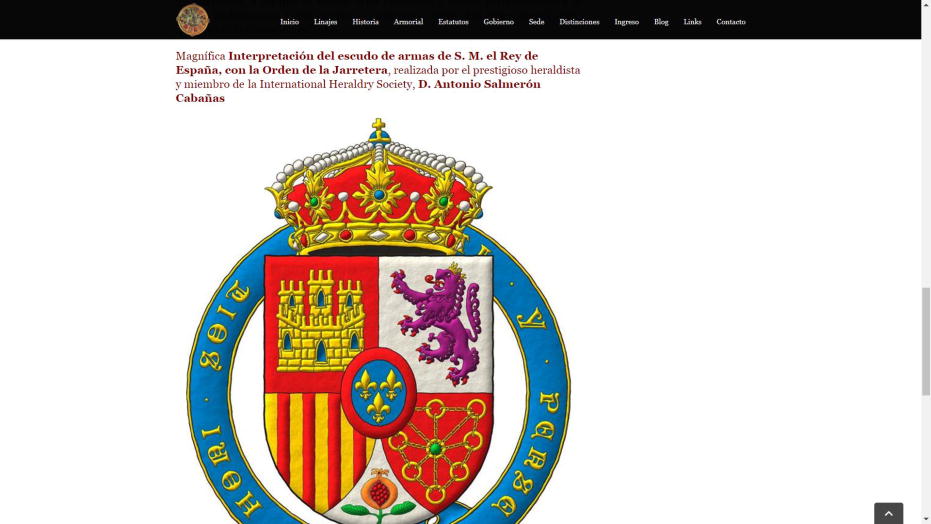
![Felipe VI of Spain and the golden number Quarterly: 1 Gules, a castle triple-towered Or, port and windows Azure, masoned Sable [for Castile]; 2 Argent, a lion rampant Purpure, armed and langued Gules, crowned Or [for Leon]; 3 Or, four pallets Gules [for Aragon]; 4 Gules, a chain orlewise, crosswise, and saltirewise Or, charged in the fess point with an emerald Vert [for Navarre]; enté en point Argent, a pomegranate proper, seeded Gules, slipped and leaved Vert [for Granada]; an inescutcheon Azure, three fleurs de lis Or, 2 and 1, a bordure Gules [for Bourbon]. Crest: A closed royal crown. The shield is surrounded by the Golden Fleece.](../escudo_armas/FelipeVI.13.Aurea.Dimensiones.Esquema.1x3.jpg)
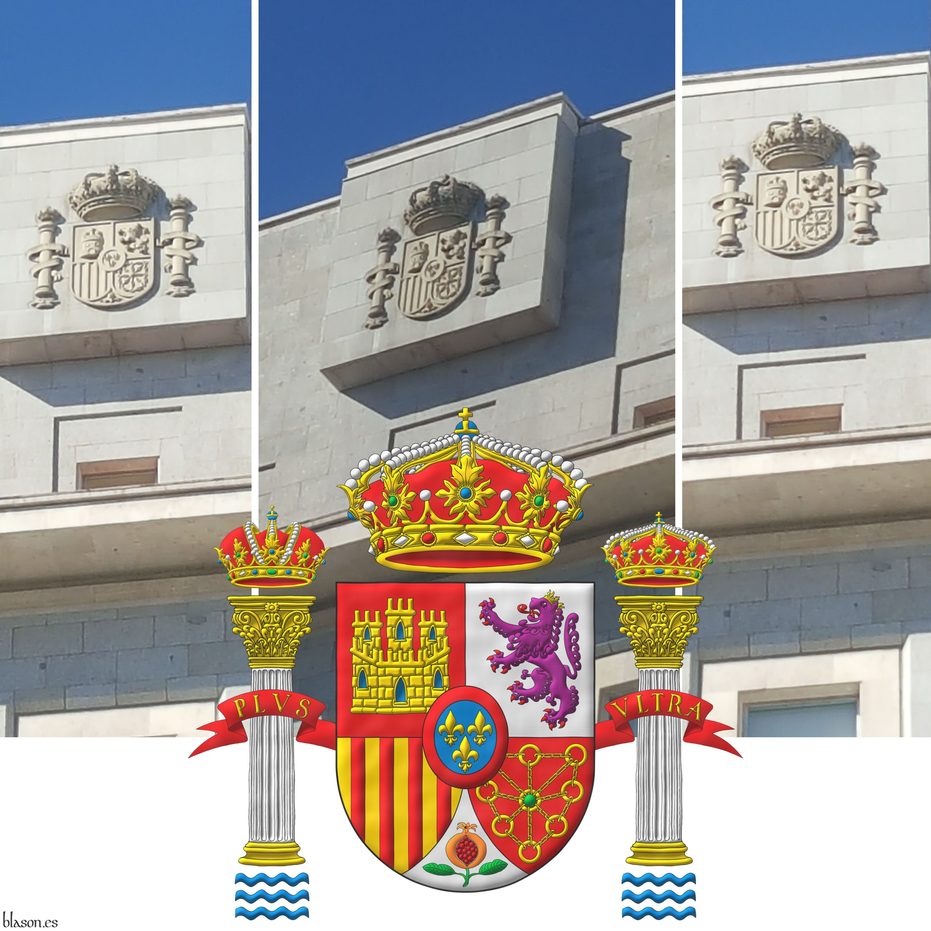
![Kingdom of Spain, schema 4x6 Quarterly: 1 Gules, a castle triple-towered Or, port and windows Azure, masoned Sable [for Castile]; 2 Argent, a lion rampant Purpure, armed and langued Gules, crowned Or [for Leon]; 3 Or, four pallets Gules [for Aragon]; 4 Gules, a chain orlewise, crosswise, and saltirewise Or, charged in the fess point with an emerald Vert [for Navarre]; enté en point Argent, a pomegranate proper, seeded Gules, slipped and leaved Vert [for Granada]; an inescutcheon Azure, three fleurs de lis Or, 2 and 1, a bordure Gules [for Bourbon].](../escudo_armas/EspanaR.18.6Escudos.Esquema.4x6.TrazoAlzado.jpg)
